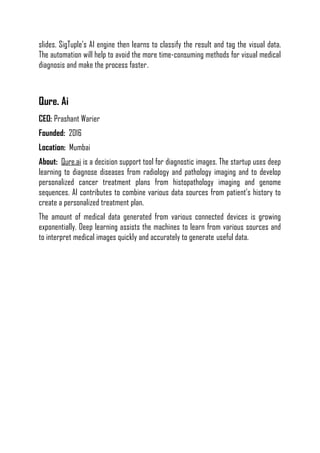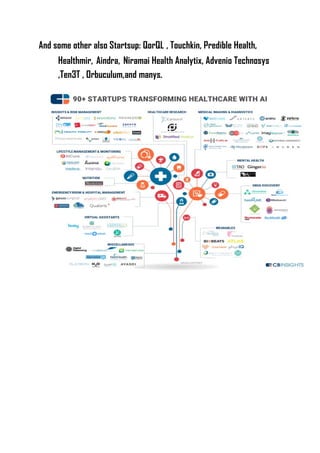Intro/Overview on Machine Learning Presentation -2
- 1. An Overview OF MACHINE LEARNING Power point Presentation BCE- C 560 Submitted By: Ankit gupta B.Tech, Cse, V Sem Roll no:16 Submitted To: Mr. Nishant munjal Assistant Professor CSE Department, Fet, Gkv DEPARTMENT OF COMPUTER SCIENCE & ENGINEERING FACULTY OF ENGINEERING AND TECHNOLOGY GURUKUL KANGRI UNIVERSITY 2017-2018
- 2. What is Machine Learning? Machine learning is an application of artificial intelligence (AI) that provides systems the ability to automatically learn and improve from experience without being explicitly programmed. Machine learning focuses on the development of computer programs that can access data and use it learn for themselves. The process of learning begins with observations or data, such as examples, direct experience, or instruction, in order to look for patterns in data and make better decisions in the future based on the examples that we provide. The primary aim is to allow the computers learn automatically without human intervention or assistance and adjust actions accordingly. Arthur Samuel in 1959: “[Machine Learning is the] field of study that gives computers the ability to learn without being explicitly programmed.” And more recently, in 1997, Tom Mitchel : “A computer program is said to learn from experience E with respect to some task T and some performance measure P, if its performance on T, as measured by P, improves with experience E.” -- Tom Mitchell, Carnegie Mellon University : Machine learning enables analysis of massive quantities of data. While it generally delivers faster, more accurate results in order to identify profitable opportunities or dangerous risks, it may also require additional time and resources to train it properly. Combining machine
- 3. learning with AI and cognitive technologies can make it even more effective in processing large volumes of information. Algorithm by learning Style: There are different ways an algorithm can model a problem based on its interaction with the experience or environment or whatever we count to call the input data. Three different styles in machine learning algorithm: 1.Semi-Supervised Learning Input data is a mixture of labeled and unlabelled examples. There is a desired prediction problem but the model must learn the structures to organize the data as well as make predictions. Example problems are classification and regression. Example algorithms are extensions to other flexible methods that make assumptions about how to model the unlabeled data. 2. Supervised Learning Input data is called training data and has a known label or result such as spam/not-spam or a stock price at a time. A model is prepared through a training process in which it is required to make predictions and is corrected when those predictions are wrong. The training process continues until the model achieves a desired level of accuracy on the training data.
- 4. Example problems are classification and regression. 3.Unsupervised Learning Input data is not labeled and does not have a known result. A model is prepared by deducing structures present in the input data. This may be to extract general rules. It may be through a mathematical process to systematically reduce redundancy, or it may be to organize data by similarity. Example problems are clustering, dimensionality reduction and association rule learning. Example algorithms include: the Apriori algorithm and k- Means. How will machine learning work with humans for optimal marketing? Machine learning will offer key insights into optimization, helping brands understand what people want to read. Humans will be in charge of creating high-quality content that speaks to the needs of the customers, as detailed by the machine learning. Machine learning will analyze customer behavior on websites to better understand how people progress through the buyer’s journey. Machine learning will take the content created by people and develop a more personalized experience.
- 5. Machine learning will be an important part of marketing in the future, as it will help brands better understand customer behavior and what people want to see online. Humans will always be in charge of the creative process, but this type of learning will make it easier to create a superior user experience. Learning system model: Machine learning refers to a system capable of acquiring and integrating the knowledge automatically. The capability of the systems to learn from experience, training, analytical observation, and other means, results in a system that can continuously self-improve and thereby exhibit efficiency and effectiveness. A machine learning system usually starts with some knowledge and a corresponding knowledge organization so that it can interpret, analyze, and test the knowledge acquired. The figure shown besides is a typical learning system model. It consists of the following components. 1. Learning element 2. Knowledge base 3. Performance element 4. Feedback element 5. Standard system. Machine learning refers to a system capable of acquiring and integrating the knowledge automatically. The capability of the systems to learn from experience, training, analytical observation, and other means, results in a system that can continuously self-improve and thereby exhibit efficiency and effectiveness. A machine learning system usually starts with some knowledge and a corresponding knowledge organization so that it can interpret, analyze, and test the knowledge acquired.
- 6. Learning System Model The figure shown above is a typical learning system model. It consists of the following components. 1. Learning element 2. Knowledge base 3. Performance element 4. Feedback element 5. Standard system. 1. Learning element It receives and processes the input obtained from a person ( i.e. a teacher), from reference material like magazines, journals, etc, or from the environment at large. 2. Knowledge base This is somewhat similar to the database. Initially it may contain some basic knowledge. Thereafter it receives more knowledge which may be new and so be added as it is or it may replace the existing knowledge.
- 7. 3. Performance element It uses the updated knowledge base to perform some tasks or solves some problems and produces the corresponding output. 4. Feedback element It is receiving the two inputs, one from learning element and one from standard (or idealized) system. This is to identify the differences between the two inputs. The feedback is used to determine what should be done in order to produce the correct output. 5. Standard system It is a trained person or a computer program that is able to produce the correct output. In order to check whether the machine learning system has learned well, the same input is given to the standard system. The outputs of standard system and that of performance element are given as inputs to the feedback element for the comparison. Standard system is also called idealized system. The sequence of operations described above may be repeated until the system gets the desired perfection. There are several factors affecting the performance are: • Types of training provided • The form and extent of any initial background knowledge • The type of feedback provided • The learning algorithms used. Training is the process of making the system able to learn. It may consist of randomly selected examples that include a variety of facts and details including
- 8. irrelevant data. The learning techniques can be characterized as a search through a space of possible hypotheses or solutions. Background knowledge can be used to make learning more efficient by reducing the search space. The feedback may be a simple yes or no type of evaluation or it may contain useful information describing why a particular action was good or bad. If the feedback is always reliable and carries useful information, the learning process will be faster and the resultant knowledge will be correct. The success of machine learning system also depends on the algorithms. These algorithms control the search to find and build the knowledge structures. The algorithms should extract useful information from training examples. There are several machine learning techniques available. I have explored some of the important techniques. A.I vs. Machine Learning vs. Deep Learning AI and machine learning are often used interchangeably, especially in the realm of big data. But these aren’t the same thing, and it is important to understand how these can be applied differently. Artificial intelligence is a broader concept than machine learning, which addresses the use of computers to mimic the cognitive functions of humans. When machines carry out tasks based on algorithms in an “intelligent” manner, that is AI. Machine learning is a subset of AI and focuses on the ability of machines to receive a set of data and learn for themselves, changing algorithms as they learn more about the information they are processing.
- 9. Training computers to think like humans is achieved partly through the use of neural networks. Neural networks are a series of algorithms modeled after the human brain. Just as the brain can recognize patterns and help us categorize and classify information, neural networks do the same for computers. The brain is constantly trying to make sense of the information it is processing, and to do this, it labels and assigns items to categories. When we encounter something new, we try to compare it to a known item to help us understand and make sense of it. Neural networks do the same for computers. Benefits of neural networks: • Extract meaning from complicated data • Detect trends and identify patterns too complex for humans to notice • Learn by example • Speed advantages Deep learning goes yet another level deeper and can be considered a subset of machine learning. The concept of deep learning is sometimes just referred to as "deep neural networks," referring to the many layers involved. A neural
- 10. network may only have a single layer of data, while a deep neural network has two or more. The layers can be seen as a nested hierarchy of related concepts or decision trees. The answer to one question leads to a set of deeper related questions. Deep learning networks need to see large quantities of items in order to be trained. Instead of being programmed with the edges that define items, the systems learn from exposure to millions of data points. An early example of this is the Google Brain learning to recognize cats after being shown over ten million images. Deep learning networks do not need to be programmed with criteria that define items; they are able to identify edges through being exposed to large amounts of data. What is the Jupyter Notebook? The Jupyter Notebook is an interactive computing environment that enables users to author notebook documents that include: - Live code - Interactive widgets - Plots - Narrative text - Equations - Images - Video
- 11. These documents provide a complete and self-contained record of a computation that can be converted to various formats and shared with others using email, Dropbox, version control systems (like git/GitHub) or nbviewer.jupyter.org. Components The Jupyter Notebook combines three components: The notebook web application: An interactive web application for writing and running code interactively and authoring notebook documents. Kernels: Separate processes started by the notebook web application that runs users’ code in a given language and returns output back to the notebook web application. The kernel also handles things like computations for interactive widgets, tab completion and introspection. Notebook documents: Self-contained documents that contain a representation of all content visible in the notebook web application, including inputs and outputs of the computations, narrative text, equations, images, and rich media representations of objects. Each notebook document has its own kernel. Notebook web application The notebook web application enables users to: Edit code in the browser, with automatic syntax highlighting, indentation, and tab completion/introspection. Run code from the browser, with the results of computations attached to the code which generated them.
- 12. See the results of computations with rich media representations, such as HTML, LaTeX, PNG, SVG, PDF, etc. Create and use interactive JavaScript widgets, which bind interactive user interface controls and visualizations to reactive kernel side computations. Author narrative text using the Markdown markup language. +++++++++ STARTUPS TRANSFORMING HEALTHCARE AI+++++++++ Important points are +++++ Taking care of human health is a quite intricate job that requires broad and multiple aspects of the healthcare industry to work together. Healthcare industry is already overburdened with the exploding population and lack of trained doctors. The ratio of doctor to patients in India is 1:1700 which is far higher than the recommended ratio of 1 in every 1000 patients by WHO. The spontaneous increase in the count of efficient healthcare providers is not possible. But the access to intelligent and smart technologies can enhance the productivity and precision of existing
- 13. ones in serving more patients in a specific time, with the ease to improve healthcare outcomes and in lowering the healthcare expense. Artificial Intelligence (AI) has the ability to throttle the pace of advancements in almost all industrial segments. According to John McCarthy, the father of Artificial Intelligence; “Artificial Intelligence is the science and engineering of making intelligent machines, especially intelligent computer programs.” AI helps humans to amalgamate human intelligence with computer technology to enhance the potential of the healthcare industry to serve better. Know about some healthcare start-ups in India who are adopting AI to accelerate the healthcare industry in a more efficient and cost- effective way.
- 14. The some startups companies are in Healthcare in India : Sigtuple – CEO: Rohit Pandey Founded: 2015 Location: Bangalore About: SigTuple is utilizing AI to build artificially intelligent pathologist for medical diagnosis. AI is utilized to analyze medical images, scans, and videos to generate information for diagnosis. Sigtuple’s product, Shonit automates the procedure of medical diagnosis to reduce the time and effort. Shonit can automatically detect diseases like anemia, malaria, leukemia and other diseases. The waiting time of the patients to get pathology reports before treatment would be reduced. Shonit comprises of digitized slides for blood test attached to a mechanical component and a smartphone to a regular microscope. The smartphone auto scans the
- 15. slides. SigTuple’s AI engine then learns to classify the result and tag the visual data. The automation will help to avoid the more time-consuming methods for visual medical diagnosis and make the process faster. Qure. Ai CEO: Prashant Warier Founded: 2016 Location: Mumbai About: Qure.ai is a decision support tool for diagnostic images. The startup uses deep learning to diagnose diseases from radiology and pathology imaging and to develop personalized cancer treatment plans from histopathology imaging and genome sequences. AI contributes to combine various data sources from patient’s history to create a personalized treatment plan. The amount of medical data generated from various connected devices is growing exponentially. Deep learning assists the machines to learn from various sources and to interpret medical images quickly and accurately to generate useful data.
- 16. And some other also Startsup: QorQL , Touchkin, Predible Health, Healthmir, Aindra, Niramai Health Analytix, Advenio Technosys ,Ten3T , Orbuculum,and manys.

![What is Machine Learning?
Machine learning is an application of artificial intelligence (AI) that
provides systems the ability to automatically learn and improve from
experience without being explicitly programmed. Machine learning
focuses on the development of computer programs that can
access data and use it learn for themselves.
The process of learning begins with observations or data, such as
examples, direct experience, or instruction, in order to look for
patterns in data and make better decisions in the future based on the
examples that we provide. The primary aim is to allow the
computers learn automatically without human intervention or
assistance and adjust actions accordingly.
Arthur Samuel in 1959:
“[Machine Learning is the] field of study that gives computers the
ability to learn without being explicitly programmed.”
And more recently, in 1997, Tom Mitchel :
“A computer program is said to learn from experience E with
respect to some task T and some performance measure P, if its
performance on T, as measured by P, improves with experience
E.” -- Tom Mitchell, Carnegie Mellon University :
Machine learning enables analysis of massive quantities of data. While
it generally delivers faster, more accurate results in order to identify
profitable opportunities or dangerous risks, it may also require
additional time and resources to train it properly. Combining machine](https://image.slidesharecdn.com/ml-181209144404/85/Intro-Overview-on-Machine-Learning-Presentation-2-2-320.jpg)








































































































